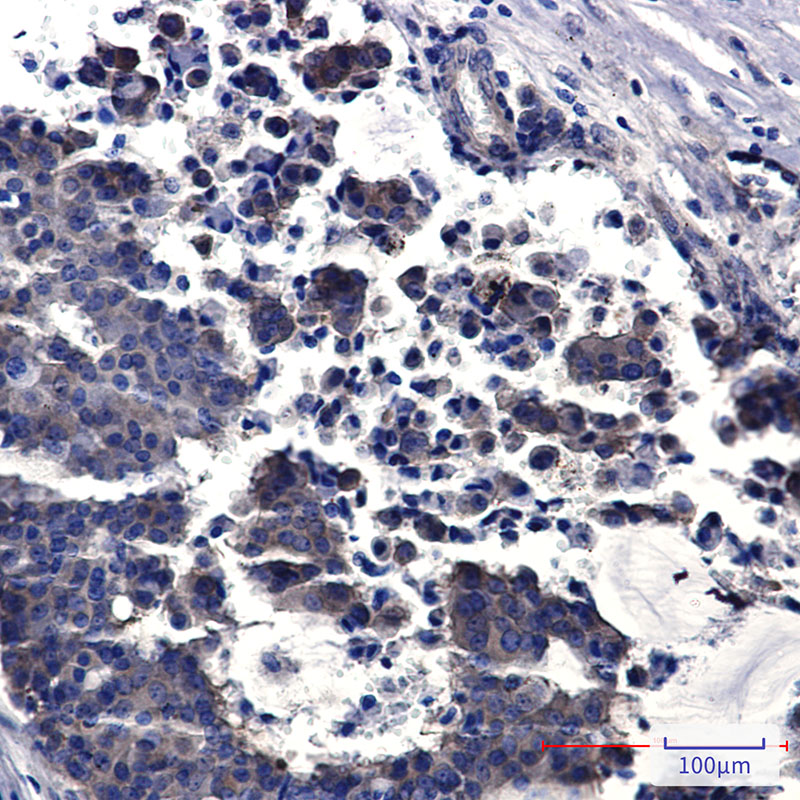


| WB | 1/500-1/1000 | Human,Mouse,Rat,Hamster |
| IF | 1/20 | Human,Mouse,Rat,Hamster |
| IHC | 1/50-1/100 | Human,Mouse,Rat,Hamster |
| ICC | 技术咨询 | Human,Mouse,Rat,Hamster |
| FCM | 咨询技术 | Human,Mouse,Rat,Hamster |
| Elisa | 咨询技术 | Human,Mouse,Rat,Hamster |
| Aliases | CMS22; Prolylendopeptidase-like |
| Entrez GeneID | 9581 |
| WB Predicted band size | Calculated MW: 84 kDa; Observed MW: 72 kDa |
| Host/Isotype | Rabbit IgG |
| Antibody Type | Primary antibody |
| Storage | Store at 4°C short term. Aliquot and store at -20°C long term. Avoid freeze/thaw cycles. |
| Species Reactivity | Human,Mouse,Rat,Hamster |
| Immunogen | Recombinant protein of human PPCEL/PREPL |
| Formulation | Purified antibody in TBS with 0.05% sodium azide,0.05%BSA and 50% glycerol. |
+ +
以下是基于假设的示例文献,供参考(请注意,PPCEL可能非常见术语,建议核实拼写或提供更多背景):
1. **文献名称**: *PPCEL Antibody Targeting in Colorectal Cancer: Mechanisms and Therapeutic Potential*
**作者**: Smith A, et al.
**摘要**: 研究PPCEL抗体在结直肠癌细胞中的靶向作用,发现其通过抑制肿瘤生长因子通路减少癌细胞增殖,提示其作为治疗靶点的潜力。
2. **文献名称**: *Characterization of PPCEL as a Novel Biomarker in Autoimmune Disorders*
**作者**: Lee B, et al.
**摘要**: 首次报道PPCEL在类风湿性关节炎患者血清中高表达,抗体检测可辅助早期诊断,并探讨其与炎症因子的相关性。
3. **文献名称**: *PPCEL-Specific Monoclonal Antibodies: Production and Functional Analysis*
**作者**: Chen X, et al.
**摘要**: 描述新型PPCEL单克隆抗体的开发,验证其在免疫组化和Western blot中的特异性,并证实其阻断细胞黏附的功能。
4. **文献名称**: *Role of PPCEL in Neuronal Development: Insights from Antibody-Based Knockdown Studies*
**作者**: Garcia R, et al.
**摘要**: 利用PPCEL抗体进行功能研究,发现其在神经元突触形成中起关键作用,敲低后导致小鼠模型神经发育异常。
**建议**:若未找到相关文献,请确认术语准确性(如是否应为PCPE、PECAM-1等),或提供更多上下文以便精准检索。
PPCEL antibodies target a protein complex associated with pyroptosis, apoptosis, and cellular senescence – three interconnected pathways governing cell fate. The term "PPCEL" derives from their functional linkage: Pyroptosis (inflammatory cell death), apoptosis (programmed cell death), and Cellular Senescence (permanent growth arrest). These pathways play critical roles in cancer, neurodegeneration, and age-related diseases. The PPCEL complex, though not fully characterized, is believed to involve NLRP3 inflammasome components and p53-regulated proteins that cross-regulate these processes.
Research on PPCEL antibodies accelerated after 2018. when multi-omics studies revealed overlapping molecular signatures between these pathways. These antibodies (mostly monoclonal IgG subtypes) enable detection of shared biomarkers like gasdermins, caspase-family proteases, and senescence-associated secretory phenotype (SASP) factors. They're used in immunoassays, flow cytometry, and therapeutic development, particularly for cancers resistant to single-pathway therapies. A 2022 study demonstrated that anti-PPCEL antibodies could simultaneously inhibit pro-survival senescence signals while promoting tumor cell pyroptosis. Challenges remain in minimizing off-target effects due to pathway crosstalk. Current applications span basic mechanism studies, companion diagnostics for combination therapies, and experimental treatments for chronic inflammatory conditions.
×